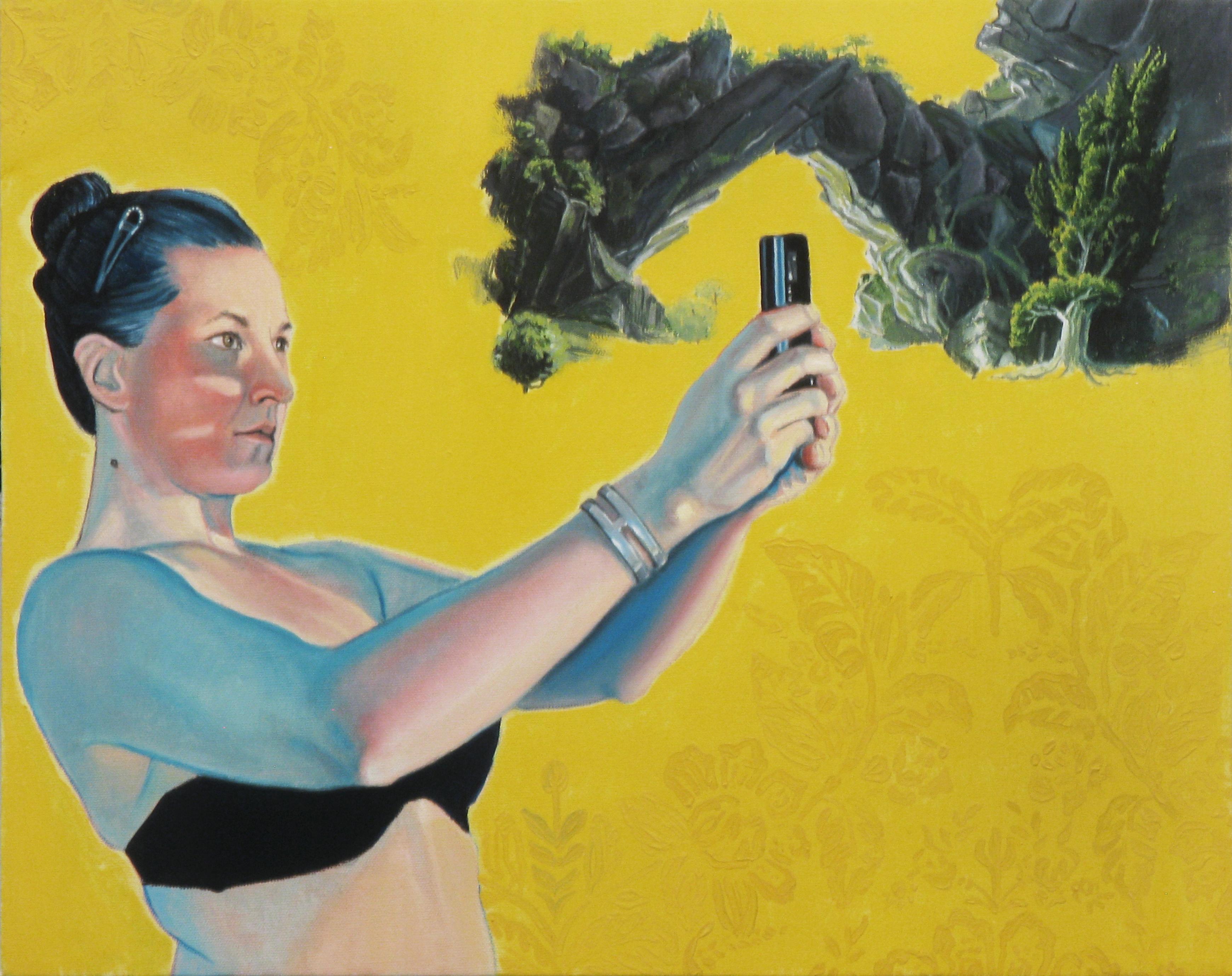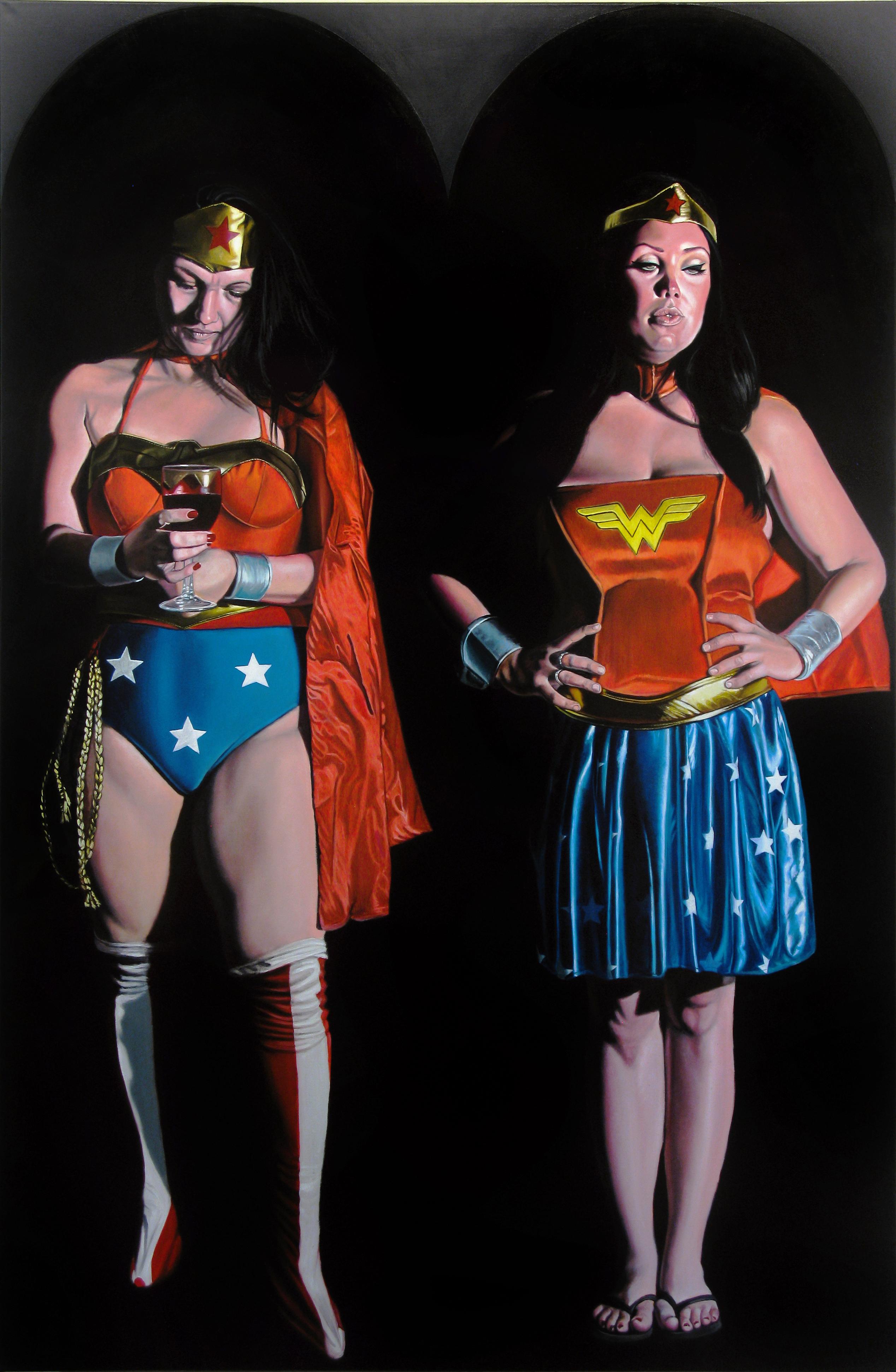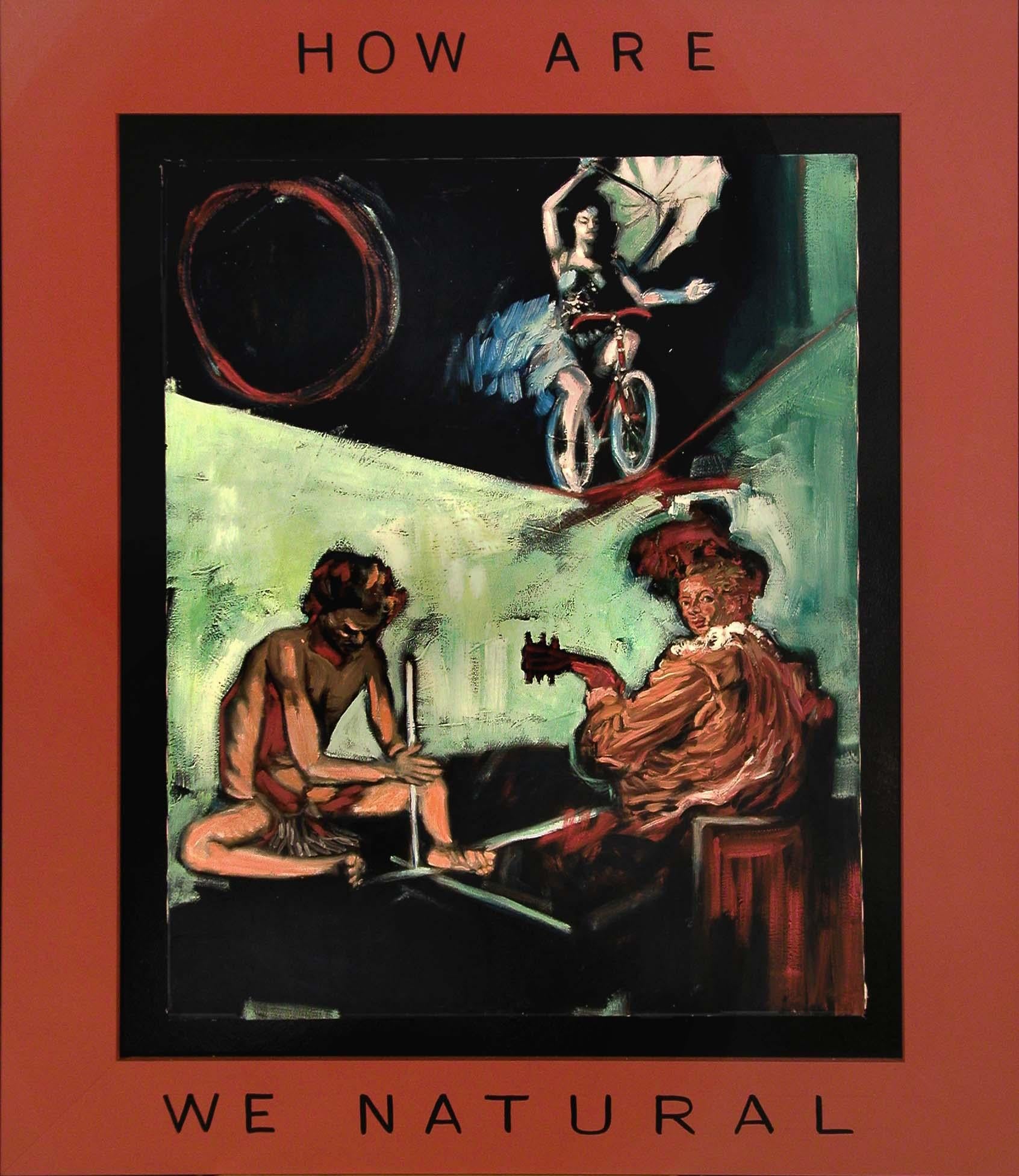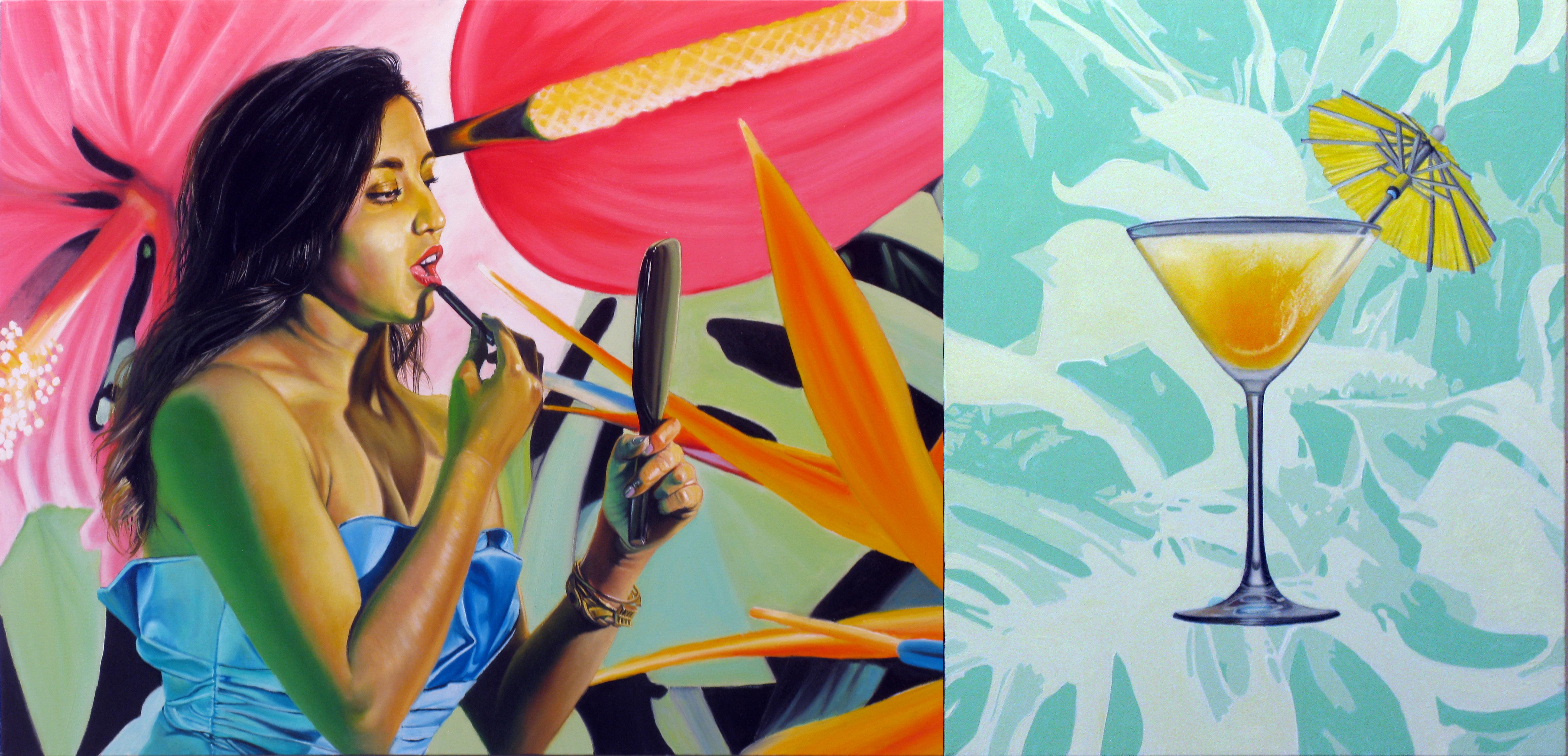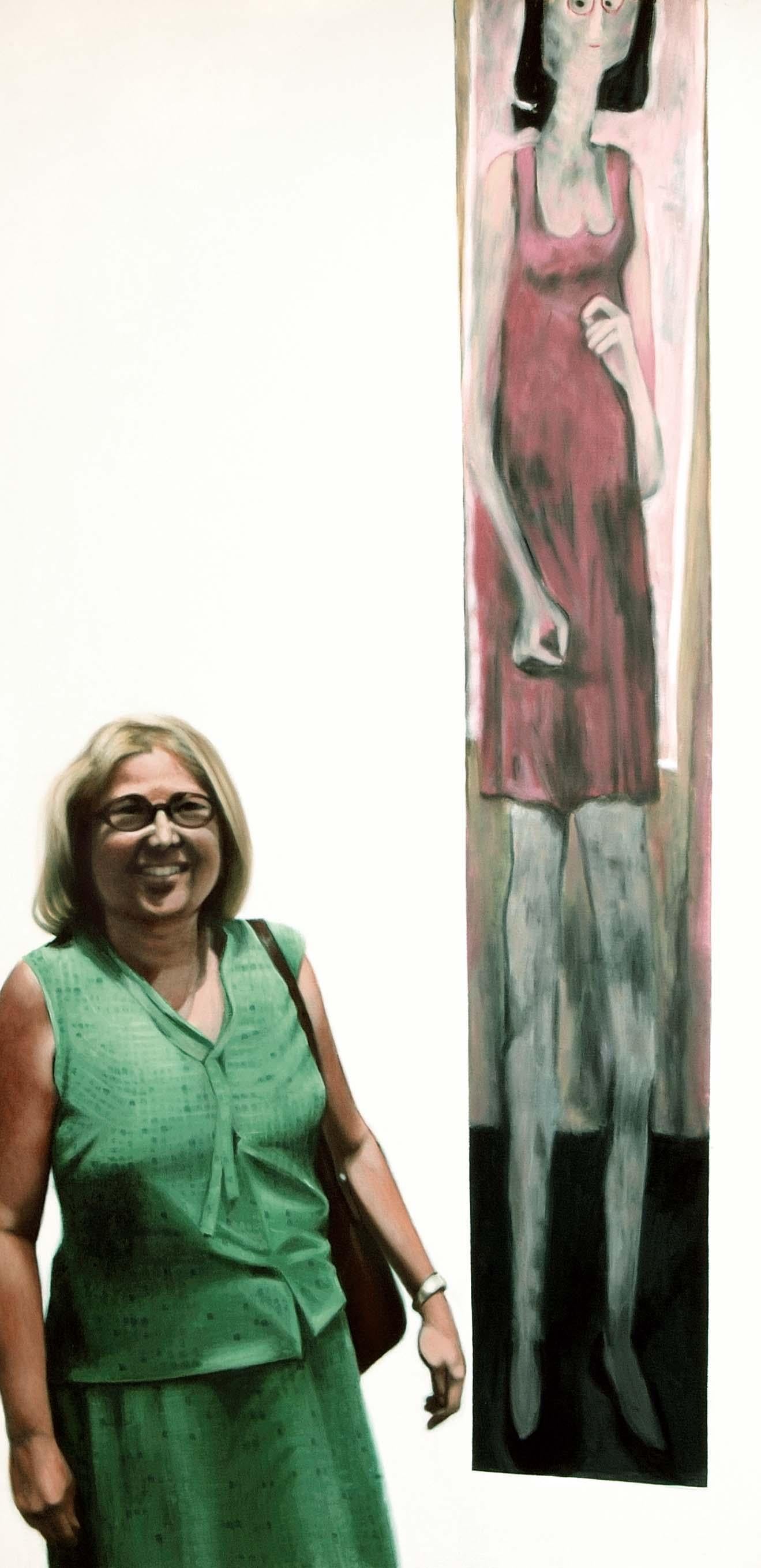Items Similar to Israeli Oil Painting Ruth Schloss Child, Doll, Wagon, Kibbutz Social Realist Art
Want more images or videos?
Request additional images or videos from the seller
1 of 11
Ruth SchlossIsraeli Oil Painting Ruth Schloss Child, Doll, Wagon, Kibbutz Social Realist Artc.1950s
c.1950s
About the Item
Large magnificent colorful Ruth Schloss oil painting of a child with a wagon with a doll or a baby in a carriage stroller.. Signed in Hebrew
size measures 31x43 with frame , 23x35.25 without the frame. (this is being sold unframed).
Ruth Schloss (22 November 1922 – 2013) was an Israeli painter and illustrator who mainly depicted neglected scenes such as Arabs, transition camps, children and women at eye-level as egalitarian, socialist view via social realism style painting and drawing.
Schloss became Israeli painting’s sensitive, conscious, remembering eye.
Ruth Schloss was born on 22 November 1922, in Nuremberg, Germany, to Ludwig and Dian Schloss, as the second of three daughters of bourgeois assimilationist Jewish family well-integrated into German culture. As the Nazis came into power in 1933, her family immigrated to Israel in 1937, and settled in Kfar Shmaryahu, then an agricultural settlement. Schloss studied at the Department of Schloss graphic design at "Bezalel" from 1938 to 1942 alongside Friedel Stern and Joseph Hirsch. She was a realistic painter who focused on disadvantaged people in the society and social matters as an egalitarian. Her realism was thus an “inevitable realism,” motivated by an inner necessity: the need to observe reality as it is.
Her painting repeatedly addressed the door pulled from its frame, employing drawing’s unique ability to stop time and prolong the image’s persistence in the retina, she repeatedly committed to paper - in a matter-of-fact, non-evasive manner devoid of mystery – man’s tendency to generate chaos, suffering and pain.
Throughout her life, Schloss remained minimalist. Painting about human fate was the main subject of her artworks. Her natural inclination was to describe the darker aspect of human existence.
1930s
The Schloss household was characterized by open, liberal spirit, in keeping with the parents’ progressive views. It deeply influenced Ruth’s mental development, as she learned to tie culture and art with sensitivity towards the weak and underprivileged.
In Jerusalem, she joined a commune of Hashomer Hatzair in which she shaped her socialist views, which she maintained throughout her long career.
1940s
In this period she mainly depicted landscapes of kibbutz and wretched women living hard life, children in huger, older people, refugees. After completing her art studies, Schloss joined a training group at Kibbutz Merhavia in 1942, and after two years moved to Karkur region, the nucleus established Kibutz Lehavot Habashan in the Upper Galilee. Through this time, she fell in love with the surroundings and drew landscapes. They are simple and direct with fresh, lucid lines. These paintings were selected as the main works of her first exhibition in 1949.
In early 1945, Schloss started to draw illustrations in the children’s magazine Mishmar Leyeladim, and designed the logo of Al Hamishmar, the paper’s new name in 1948. In 1948, upon the founding of Mapam (United Workers’ Party), she designed her party’s emblem, which became a well-known icon. She kept working as an illustrator for Mishmar Layeladim until 1949.
"Mor the Monkey" project yielded financial profits and this income was used for a study trip to Paris for two years. She was succesfull as illustrator however, she had inner conflicts of her identity as witnessed painter toward neglected class in Israeli society.
First Exhibition at Mikra-Studio Gallery, 1949
She presented forty drawings on paper in her first solo exhibition, representing a selection of the themes of kibbutz landscape, its lifestyle. Schloss confidently proposed her direction through simplicity without using colors in her drawings.
1950s
Between 1949 and 1951, she studied at the Académie de la Grande Chaumière in Paris.
She began working in oils, with which she continued throughout the 1960s.
The exhibition “Back from Paris” opened in November 1951 at Mikra-Studio Gallery .
In 1951 she married Benjamin Cohen, who served as chairman of the national leadership of Hashomer Hatzair Workers Party in Tel Aviv. He was a theoretician and a man of principle, highly esteemed by its leaders who became a professor of history at Tel Aviv University. In 1953, following the Mordechai Oren affair and the publication of Moshe Sneh 's followers from Kibbutz Artzi, she and her husband left the kibbutz and moved to the agricultural farm, Kfar Shmaryahu, where she lived until her death.
At a certain point in Israeli history, segments of the socialist movement felt that Israel should become part of the Communist bloc, rather than seek the support of the western world. Because the Schloss couple support of Moshe Sneh’s left-wing party, they had to leave the kibbutz.
She loved to depict ordinary women as figurative on her painting without hiding or making up anything. The poet Natan Zach wrote about her works in 1955: “Her motto remains that which has been all these years: life as it is, without bluffing."
Schloss’s “Pietà” (1953) became a universal cry expressing the pain of mothers on either side of the divide. In the late 1950s, she was the mother of two daughters. When she drew her daughters, unlike the universal babies she depicted, naked and with clenched fists, the painting of her children employed babyish sweetness to the full in a quiet, peaceful and heart-stirring filling rather than urgency. She also painted children in the transition camp and Jaffa in the 1950s and 1960s.
1960s-1980s – The period of Studio in Jaffa
Schloss painted at a studio in Jaffa from 1962 till 1983. In this time, she turned her interest to people around her more than kibbutz – the children, mothers, and poor workers, the alleys and houses. She opened the space to the street and its dwellings, built interactions around it, and was nurtured by the presence of the outside in her work.
1960s Schloss familiarized to an Arab woman, Nabava, lived in poor. Schloss returned to painting images of old people later, and she called her painting figurative elderly people in the old age homes “waiting”.
In the late 1960s, Ruth discovered acrylic paint and never turn back to oil painting.
In 1965 Schloss devoted a series “Area 9 (1965)”, dedicated to the demolition of Israeli-Arab houses and the expropriation of the land, and carried a definite socio-political messages. The series was exhibited at Beit Zvi, Ramat Gan, in 1966. She was the only artist who addressed the result of the Six-Day War immediately afterward. In 1968, Schloss and Gansser-Markus presented “Drawing of War” in Zurich gallery. She expressed the war as an ultimate expression of destruction and ruin, regardless of victors and vanquished.
1970s In late 1970s Schloss began printing the selected photograph directly on the canvas, posterior reworking it in acrylic. She decided to print her work at Har-El Printers in Jaffa, and these became the surface of her painting. This technique was mainly adopted in two large series: Anne Frank (1979-1980) and Borders (1982). Through this technique she placed the figure of elder Frank next to that of the famous young Frank, and released it at the exhibition at Bet Ariela Cultural Center, Tel Aviv, in 1981. The series touched upon the Nazi Holocaust.
1980s The Lebanon War raised the question of “The Good Fence” and the effect of the war. She dedicated a large series Boarders, one of the most powerful image linked to the series is the figure of Yemenite woman raising her hand. She was the first to raise the Black Panthers demonstration to the level of a social icon. In the 1980s and again in 2000, the Intifada uprisings also led Schloss to the easel to render a good number of representational and symbolic works that in their way denounced Israel's political and military actions.
1990s – 2000s Ruth Schloss never had an exhibition in a major Israeli museum. Her works were presented in private galleries and small museums. The main museums, the Tel Aviv Museum of Art and the Israel Museum, included her works only in group exhibitions, and only in 1991 was her retrospective exhibited at the Herzliya Museum.
In the 2000s, Schloss’s metaphors turned into animal kingdom and Bedouins in the south. A huge rhinoceros, birds of prey, and other "bad animals," as Cohen Evron, daughter of Ruth, calls them and "I connected this to the Nazis," said Schloss. Schloss' work after she didn't find human expression able to transmit the endless cruelty she saw in Israel's political mentality.
Schloss also continued to follow and collect documentary photographs of destructions of houses from the war, the Intifada, the sequence of her work about ruin from 1949 to 2005, was a cumulative testimony about the painful history of Israel and Palestine.
In 2006, a large retrospective exhibition of her work was presented at the Museum of Art in Ein Harod, curated by Tali Tamir.
Education
1938-41 Bezalel Art Academy, Jerusalem, with Mordecai Ardon
1946 painting course for Kibbutz Artzi artists with Yohanan Simon and Marcel Janco
1949-51 Académie de la Grande Chaumière, Paris
Awards and recognition
1965 Silver Medal, International exhibition in Leipzig, Germany
1977 Artist-in-Residence, The Cité Internationale Universitaire de Paris
Selected solo exhibitions
2004 “Micha Baram, Ruth Schloss: Painting-Photography,” The Art Gallery, Kibbutz Cabri, Israel, Curator: Drora Dekel
2003 “Works on Photographic Paper,” The Artists’ House, Jerusalem, Curator: Irit Levin
2001-2003 “Ruth Schloss: Reacting to Reality, Works 1982-2002,” Habama Center, Ganei Tikva, Israel (curators: Irit Levin, Miri Krymalowski)
2001 “The Last Years,” Givatayim Theater, Israel (curators; Irit Levin, Doron Polak)
2001 “Works, 1991-2001,” Beit Gabriel, Tzemach, Israel
1999 “New Born,” Nophr Art Gallery, Tel Aviv
1998-2004 “Anne Frank in Perspective,” Kunstraum am Hallop, Memmingen, Germanyת Traveling exhibition in France (as part of “Semaine contre le Racisme”)
1997-1999 “In the Footsteps of Caravaggio,” Municipal Gallery, Kfar Saba, Israel
1997 “Past Time,” Nama Gallery and Shai Gallery, Tel Aviv
1993 “People and Years,” Nelly Aman Gallery, Tel Aviv
1992 “Ruth Schloss: Retrospective, 1942-1992,” Herzliya Museum of Art
1989 “Intifada: New Works,” Tiroche Gallery, Tel Aviv
1989 “Borders,” Produzentengalerie, Zurich
1982 “Borders 82,” Herzliya Museum, Israel
1975 Rosenfeld Gallery, Tel Aviv
1974 Mishkan Le’Omanut, Beit Meirov, Holon, Israel
1968 “Drawing of War,” Forum Gallery, Zurich (with photographer Ursula Gransser-Markus)
1966 “Area 9,” Beit Zvi, Ramat Gan, Israel
1957 The Artists’ House, Jerusalem
1956 Traklin Gallery, Haifa
1953 The Artists’ House, Jerusalem
1949 Mikra Studio Gallery, Tel Aviv
Selected group exhibitions:
2015 Israeli Art: The Renewed Collection Galleries, Dr. Julius and Hilde Merzbacher Galleries and the Ayala Zacks Abramov Pavilion for Israeli Art, Israel Museum, Jerusalem
Artists: Reuven Rubin, Ephraim Moses Lilien, Yitzhak Danziger, Lea Nikel, Naftali Bezem, Mordecai Ardon, David Reeb, Ruth Schloss, Yehiel Shemi, Menashe Kadishman, Avigdor Arikha, Moshe Gershuni, Moshe Geva, Tsibi Ginton, David Gitlin, Michael Klapisch, Liliane Klasmer, Gabi Krakauer, Leopold Moshe Kupferman, Sigalit Landau, Moshe Mokady, Ori Reisman, Yehezkel Streichman, Anna Ticho, Sionah Tagger and others.
2006 “Hero – Antihero,” Municipal Gallery, Kfar Saba, Israel, curator: Irit Levin
2005 “Nostalgie de Paris,” Ein Hod Gallery, Israel, curator: Avraham Eilat
2005 “Wounds and Bandaging,” The Art Gallery, Umm el-Fahem, Israel, curator: Eif Gan
2004 “ The Art of Aging,” The Jewish Institute of Religion Museum, Hebrew Union College, New York, curators: Ayana Friedman, Laura Kruger (cat.)
2004 “Drawing. Old & New,” Municipal Gallery at Beit Yad Labanim, Raanana, Israel, curator: Oded Feingersh (cat.),
2004 “Thirty + Three,” Haifa Theater, curator: Smadar Schindler
2004 “You Don’t Look Hungry to Me,” Limbus Gallery, Tel Aviv, curators: Michal Shamir, Orly Wolkowiski
2003 “Ten Women and One Old Man,” Habama Center, Ganei Tikva, Israel, curator: Miri Krymolowski
2003 “Ruins Revisited: The image of the Run in Israel 1803-2003,” Time for Art – Israel Art Center. Tel Aviv, curator: Gideon Ofrat (cat.)
2003 “Wandering Library: Markers IV,” Museo Ebraico di Venezia, Venice, curator: Doron Polak (cat.)
2002 “Imagine: Artists for Coexistence,” The Art Gallery, Umm el-Fahem, Israel; Plonit Gallery, Tel Aviv
2002 “Artist Against the Occupation,” Beit Uri and Rami Nehushtan, Kibbutz Ashdot
2002 Yaakov Meuhad, Israel, curator: Doron Polak
2001 “Against Violence against Women,” Bar-David Museum of Jewish Art and Judaica, Kibbutz Bar’am, Israel, curator: Hanna Barak (cat.)
2001 “Current Affairs,” The Art Museum, Kibbutz Hanita, Israel, curator: Hanna Barak
2001 “Traces: Contemporary Drawing in Israel,” The artists’ House, Jerusalem, curator: Ilan Wizgan, (cat.)
2000 “The Third Color,” The artists’ House, Jerusalem, curator: Ayana Friedman (cat.)
2000 “Women Artists in Palestinian Art,” Bar-David Museum of Jewish Art and Judaica, Kibbutz Bar’am, Israel,
1998 “Women in Israel Art,” Haifa Museum of Art, curator: Ilana Teicher
1998 “Scream Quietly Please,” The 9th Triennial, New Delhi, India, curator: Nella Cassouto
1998 "The East: Orientalism in the Arts in Israeli,” The Israel Museum, Jerusalem, Curator: Yigal Zalmona
1998 “Social Realism in ‘50s, Political Art in the ‘90s,” Haifa Museum of Art, Curator: Gila Ballas
1998 “Homeland Bound: Form the Dream of a National Home to the Dream Home,” The Israel Museum, curator: Tami Schatz
1997 “At Eye Level,” The Artists’ House, Jerusalem, curator: Nella Cassouto
1997 “Remembering Shlomo: Shlomo Weizmann, 1954-1995,” The Art Gallery, Ben Gurion University of Negev, Beer Sheva, Israel, curator: Haim Finkelstein
1992 “Making Peace: In Memory of the Six Day War and the Lebanon War,” exhibitions and meetings, on behalf of the Center for Peace, Givat Haviva, Israel
1991 “The Color Khaki: The Soldier in Israel Art,” Habima Theater, Tel Aviv, curator: Gideon Ofrat
1991 “Animals,” Erek Gallery, Tel Aviv
1989 “To Live with the Dream,” Tel Aviv Museum of Art, curator: Batia Donner
1989 “Portrait,” traveling exhibition, Omanut La’am, Israel, curator: Zvi Tadmor
1988 “A People Builds Its Dream: Israeli History as Reflected in Art,” Herzliya Museum, Israel, curator: Ramy Cohen
1988 “Haifa: Portrait of the City in Painting and Photography,” Haifa Museum of Modern Art, curator: Gabriel Tadmor
1988 “1948: The War of Independence in Israeli Art,” Eretz Israel Museum, Tel Aviv, Curator: Gideon Ofrat
1987 “New Bezalel: 1935-1955,” The Artists’ House, Jerusalem, curator: Gideon Ofrat
1986 “The 49th anniversary of Victory over Nazi Germany,” Municipal Art Gallery, Arad, Israel
1982 “Opinions,” The Artist’ House, Jerusalem
1978 “Artist and Society in Israeli Art 1948-1978,” The Tel Aviv Museum, curator: Sara Breitberg
1977 “Propaganda and Vision: Israeli and Soviet Art, 1930-1955,” The Israel Museum, Jerusalem, curator: Batia Donner
1971 “Israeli Art,” The Tel Aviv Museum, curator: Haim Gamzu
1970 “Exhibition of Drawings from the Museum Collection,” Haifa Museum of Modern Art
1965 “Exhibition of Drawings, 1965,” Haifa Museum of Modern Art
1951 “Back from Paris,” Mikra-Studio Gallery, Tel Aviv
1947 “Artists in the Kibbutz and in the Army,” Mikra-Studio Gallery, Tel Aviv
- Creator:Ruth Schloss (1922 - 2013)
- Creation Year:c.1950s
- Dimensions:Height: 31 in (78.74 cm)Width: 43 in (109.22 cm)
- Medium:
- Movement & Style:
- Period:
- Condition:good. minor wear size measures 31x43 with frame, 23x35.25 without the frame. (frame has wear. this is being sold unframed).
- Gallery Location:Surfside, FL
- Reference Number:1stDibs: LU38214091042
About the Seller
4.9
Platinum Seller
These expertly vetted sellers are 1stDibs' most experienced sellers and are rated highest by our customers.
Established in 1995
1stDibs seller since 2014
1,546 sales on 1stDibs
Typical response time: 1 hour
- ShippingRetrieving quote...Ships From: Surfside, FL
- Return PolicyA return for this item may be initiated within 3 days of delivery.
More From This SellerView All
- Oil Painting Israeli Bronze Menorah Tallit Judaica Still Life Bar Mitzvah SceneBy Roberto LupettiLocated in Surfside, FLFrame is 23 X 27, Canvas is 16 X 20 Born in Milan, Italy Lupetti studied at the Royal Academy in Rome where he received classical training and was apprenticed to the school of restoration at the Vatican. At the age of fourteen he was accepted to attend Brera Liceo Artistico, one of the most prestigious art academies in Italy, graduating at age eighteen and then went on to win honors from the Royal Academy of Fine Arts in Rome eventually receiving the degree of Professor of Fine Arts. In Milan, he helped restore the famed La Scala Opera House, and in Rome he earned the right to help in the restoration of the Masters' Works in the Vatican's Sistine Chapel. Following service in WWII, Roberto came to America sponsored by the famous conductor Arturo Toscanini. A painting he did of the maestro was purchased by the San Francisco Art Commission. He moved to San Francisco where he taught at the Art Institute. Roberto Lupetti (1918 - 1997) was active/lived in California / Italy. Roberto Lupetti is known for Figure, ship, still life painting. Particularly judaic rabbi paintings and Jewish genre scenes. Lupetti earned five degrees from the Italian Royal Academy of Fine Arts, was a team member for the refurbishment of the Vatican's Sistine Chapel, and immigrated to the U.S after World War II. Known for his Renaissance art and large murals, he created a few western genre pieces, including a Day in the Life of A Cowboy (5) 5'x10' murals were painted oil on masonite in 1959. He was born in 1917. He painted very few seascapes, preferring to paint scenes of fishermen on ships, usually in a storm setting. He lived all his life in America on the west coast, mostly in Carmel and Carmel Valley, California. As well as decorating churches throughout the U.S., he also painted portraits of such celebrities as Ingrid Bergman, Barbara Stanwyck, and General George Marshall. Roberto Lupetti earned five degrees at the Royal Academy of Fine Arts. Roberto was married to fellow artist Lynn Lupetti...Category
20th Century Realist Portrait Paintings
MaterialsCanvas, Oil
- Polish Judaica Portrait of Hasidic Rabbi with Tallit Synagogue Oil PaintingLocated in Surfside, FLRealistic portrait of an old Jewish shtetl type pulpit rabbi by a Polish artist. Here the artist conveys a sense of quiet grandeur through the eyes of his subject and the way it's re...Category
20th Century Realist Portrait Paintings
MaterialsCanvas, Oil, Board
- Judaica "The Rebbe'" European Hasidic Rabbi Oil PaintingLocated in Surfside, FLRealistic portrait of an older rabbi visiting and blessing a child in a European marketplace. Here the artist conveys a sense of quiet grandeur th...Category
20th Century Realist Portrait Paintings
MaterialsCanvas, Oil
- Judaica "The Rebbe'" European Hasidic Rabbi Portrait Oil PaintingBy Charles HannafordLocated in Surfside, FLSigned with monogrammed initials and has his name written on verso. Realistic portrait of an older rabbi. CHARLES E. HANNAFORD, English; 1863-1955, Hannaford was a British waterco...Category
20th Century Realist Portrait Paintings
MaterialsCanvas, Oil
- Polish Judaica Portrait of Hasidic Rabbis Shtetl Oil PaintingLocated in Surfside, FLRealistic portrait of an older pair of Jewish shtetl types in a warm discussion by Polish artist. Here the artist conveys a sense of quiet grandeur through the eyes of his subject an...Category
20th Century Realist Portrait Paintings
MaterialsCanvas, Oil, Board
- Itzhak Holtz (Judaica Master) Oil Painting Portrait John Sloan Ashcan Artist WPABy Itshak HoltzLocated in Surfside, FLOil Painting Portrait of Ashcan Artist John Sloan. Signed I. Holtz. The youngest of four children, Holtz was born and spent his early childhood in Skierniewice, Poland, a small town near Warsaw. His father was a hat maker and a furrier. In 1935, prior to World War II, when Holtz was ten years old, his family moved to Jerusalem, Israel, where they settled in the Geula neighborhood near Meah Shearim. Itzhak Holtz's passion for art began early. When he was five years old, in Poland, his father first drew a picture of a horse and sled in the snow for him. The young Holtz looked at the drawing and studied it in wonderment. From that moment on, Holtz remembers, he constantly begged his father to draw for him. His enthusiasm for art grew and Holtz longed to study art. In 1945, he enrolled at the Bezalel Academy of Art and Design in Jerusalem, where he primarily studied lettering and poster work in a program geared toward commercial art Holtz became interested in painting, prompting him to move to New York City in 1950 to study at the Art Students League of New York under Robert Brackman and Harry Sternberg, and then at the National Academy of Design under Robert Philipp. Holtz has stated that his artwork, which primarily but not exclusively, depict scenes of Jewish spirituality and tradition, is driven by his Orthodox Jewish beliefs: "You have to live that religious life to fully capture it on canvas." He has been classified in the school of genre painting, often depicting street scenes of ordinary people in everyday Jewish life in the back alleys and markets of Jerusalem neighborhoods such as Me'ah Shearim and Geula; and in New York neighborhoods and hamlets such as Monsey, Boro Park and Williamsburg. Along with street scenes, his work includes portraits of scribes, tailors, cobblers and fishmongers, and images such as shtetls, lighthouses, and wedding scenes. He started out painting mostly portraits in order to support his family, before expanding to include street scenes. His beloved subject matter is painting scenes of Jewish life, his childhood memories when his mother took him along shopping for the Sabbath to the markets of Meah Shearim, has left a deep impression on him and influenced many of his works. Holtz has experimented in the abstract, but then reverted to representational and figurative art to which he devoted himself exclusively. His Israeli street scenes are said to combine “an affectionate recollection of the past with the brilliance of the color of modern Israel.” Holtz has stated that he struggled at first when he arrived to the USA because of financial reasons and because he only knew Polish, Yiddish and Hebrew, but then made good ties with his instructor who greatly influenced him Robert Philipp who helped him make friends and referred him to paint portraits. Examples of Holtz's work throughout the years include: Yerusalem Wedding (2010), depicting a Chuppa in Jerusalem on early evening, oil on canvas; The Funeral(1966), depicting five stoic Hasidim carrying a body on a bier over to a gravesite, with the people behind them crying, in charcoal on paper and oil on canvas; Rejoicing (1974), an image of religious men dancing, in felt pen and marker on paper; and the oil painting Shamash Learning in Shul (2003), a portrait of a pious Jew studying the Talmud inside a claustrophobic synagogue scene. Throughout the years Holtz has created hundreds of works in many art mediums, including, genre scenes, portraits, still lifes and landscape scenery, his works are sought after by art collectors worldwide, and he has been called the greatest living Jewish artist. It is said that no artist ever explored the Jewish subject like Holtz. Today some of his oil paintings have been commanding over $100,000. Holtz creates his scenes after researching locations, and often uses locals as models. He paints slowly and with great care, but with a swift Impressionistic style. The people in his portraits and scenes are generally more cheerful and optimistic than standard portraits of Hassidic individuals. He paints oils and watercolors, and also does felt pen, pastel, marker, ink and charcoal drawings, as well as woodcuts. His oil paintings typically have a brown hue, while his work with felt pen is often in sepia tones, and on some of his works he used very bright colors, with a strong emphasis on the interplay of light and shadow. He is heavily influenced by the ancient staircases and alleyways of Jerusalem, with its modest religious population, which has made a strong impression on him in his youth, the streets of Tzfat, and the works of Rembrandt, Johannes Vermeer and Peter Bruegel, as well as Jewish artists Moritz Daniel Oppenheim...Category
1940s Realist Portrait Paintings
MaterialsCanvas, Oil
You May Also Like
- Oil Painting / Photorealism / Figurative Art / Human Figure /MuseumBy Bruce AdamsLocated in Buffalo, NYBruce Adams was a painter, art educator, and writer. Born in Buffalo, N.Y., in 1952, he received a B.S. in 1976 and an M.A. in 1983 from Buffalo State College. Adams’s work is includ...Category
2010s Realist Figurative Paintings
MaterialsCanvas, Oil
- Oil Painting / Abstract versus Figurative Art / Figurative Art / Human Figure /By Bruce AdamsLocated in Buffalo, NYBruce Adams was a painter, art educator, and writer. Born in Buffalo, N.Y., in 1952, he received a B.S. in 1976 and an M.A. in 1983 from Buffalo State College. Adams’s work is includ...Category
1980s Realist Figurative Paintings
MaterialsCanvas, Oil
- Oil Painting / Photorealism / Figurative Art / Human Figure /MuseumBy Bruce AdamsLocated in Buffalo, NYBruce Adams was a painter, art educator, and writer. Born in Buffalo, N.Y., in 1952, he received a B.S. in 1976 and an M.A. in 1983 from Buffalo State College. Adams’s work is includ...Category
2010s Realist Figurative Paintings
MaterialsCanvas, Oil
- Oil painting / Portrait / Figurative/ Museum/ Interior/ Expressive/ TextBy Bruce AdamsLocated in Buffalo, NYBruce Adams was a painter, art educator, and writer. Born in Buffalo, N.Y., in 1952, he received a B.S. in 1976 and an M.A. in 1983 from Buffalo State College. Adams’s work is includ...Category
Early 2000s Realist Figurative Paintings
MaterialsCanvas, Oil
- Untitled 021 (Cocktail dyptych)By Bruce AdamsLocated in Buffalo, NYBruce Adams was a painter, art educator, and writer. Born in Buffalo, N.Y., in 1952, he received a B.S. in 1976 and an M.A. in 1983 from Buffalo State ...Category
2010s Realist Figurative Paintings
MaterialsOil, Canvas
- Oil Painting / Photorealism / Figurative Art / Human Figure /By Bruce AdamsLocated in Buffalo, NYBruce Adams was a painter, art educator, and writer. Born in Buffalo, N.Y., in 1952, he received a B.S. in 1976 and an M.A. in 1983 from Buffalo State College. Adams’s work is includ...Category
Early 2000s Realist Figurative Paintings
MaterialsCanvas, Oil
